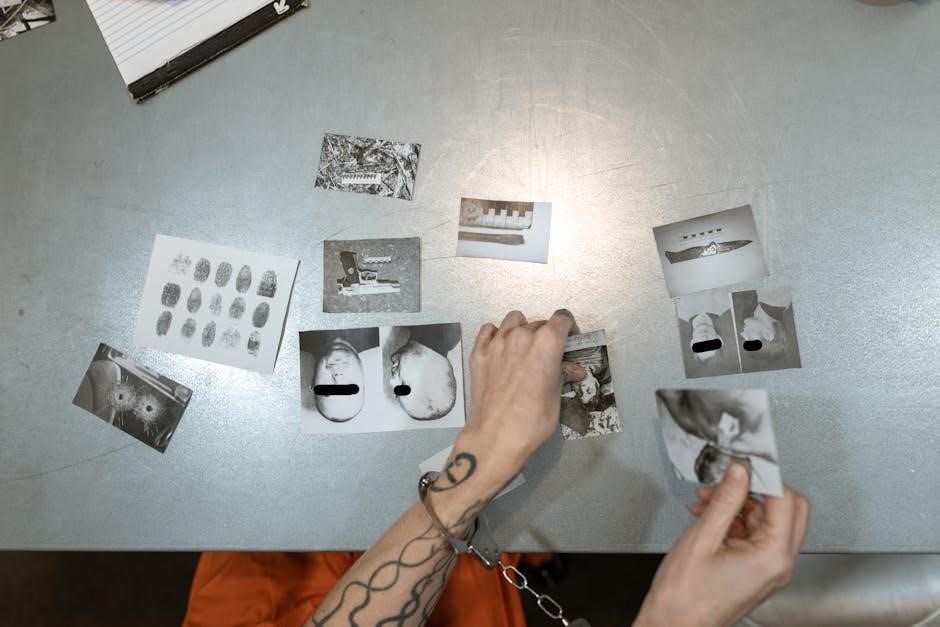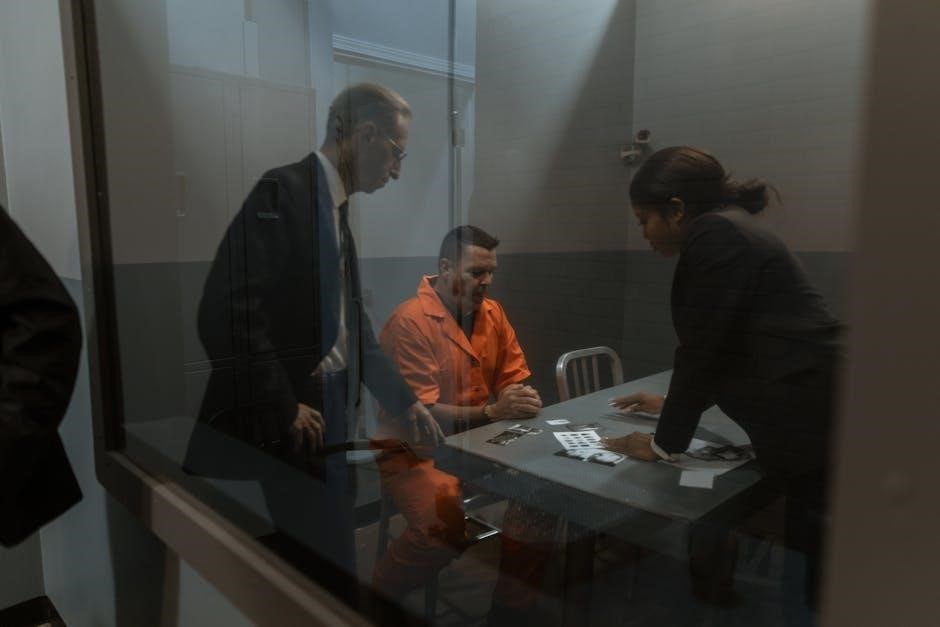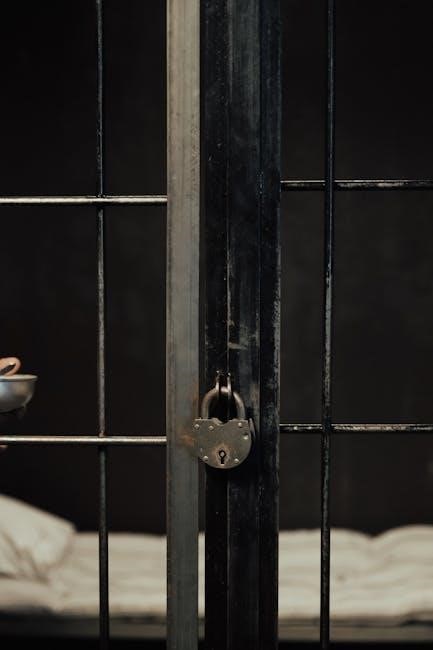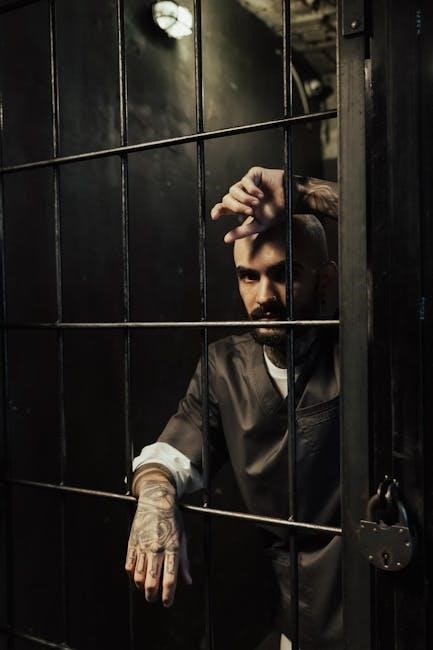The Prisoner of Azkaban, the third Harry Potter book, introduces Sirius Black and explores themes of depression and redemption, unveiling the Marauder’s Map’s significance in Harry’s journey․
1․1 Overview of the Book
Harry Potter and the Prisoner of Azkaban is the third installment in J․K․ Rowling’s beloved series, following Harry’s third year at Hogwarts․ The story begins with Harry learning about Sirius Black, a prisoner who has escaped from Azkaban, a supposedly unbreakable wizarding jail․ Believed to be coming after Harry, Black’s true identity and connection to Harry’s parents are shrouded in mystery․ The book introduces key elements like the Marauder’s Map, Remus Lupin, and the Patronus Charm, while exploring themes of depression and redemption․ The climax reveals Black’s innocence and the truth about Peter Pettigrew, adding depth to Harry’s understanding of his past and his parents’ fate․
1․2 Importance in the Harry Potter Series
The Prisoner of Azkaban is a pivotal installment in the Harry Potter series, marking a shift from the lighthearted tone of the first two books to a darker, more mature narrative․ It introduces Sirius Black, a key figure in Harry’s life, and reveals crucial details about Harry’s parents and their connections․ The book expands the wizarding world, introducing concepts like the Marauder’s Map and the Patronus Charm, which become central to the series․ It also deepens themes of depression, friendship, and redemption, setting the stage for the series’ exploration of complex moralities and the fight against injustice․

Author and Publication Details
The Prisoner of Azkaban was written by J․K․ Rowling and published in 1999 by Bloomsbury․ It became a cornerstone of the Harry Potter series․
2․1 J․K․ Rowling and Her Vision
J․K․ Rowling crafted The Prisoner of Azkaban with a vision to deepen the series’ emotional complexity․ She introduced themes of depression, redemption, and the blurred lines between good and evil, reflecting her own experiences with mental health․ Rowling’s storytelling explored the wizarding world’s darker aspects, such as the oppressive Azkaban prison and the soul-sucking dementors․ Her vision also highlighted the importance of friendship and loyalty through Harry, Ron, and Hermione’s bond․ The book’s narrative structure and character development showcased Rowling’s mastery of weaving past and present, creating a rich, immersive experience for readers․
2․2 Publication History and Reception
The Prisoner of Azkaban was published in 1999, marking a pivotal moment in the Harry Potter series․ The book received widespread critical acclaim for its darker tone and deeper exploration of themes like depression and redemption․ It solidified J․K․ Rowling’s reputation as a masterful storyteller, praised for her ability to balance complexity with accessibility․ The novel’s success further cemented the series’ global phenomenon status, with sales soaring and translations into numerous languages․
The book’s reception highlighted its emotional depth and the introduction of beloved characters like Sirius Black and Remus Lupin․ Fans and critics alike celebrated its narrative richness, making it a standout installment in the series․

Plot Summary
Harry’s third year at Hogwarts unfolds as Sirius Black escapes Azkaban, believed to be coming for Harry․ The truth about Black’s connection to Harry’s parents is revealed․
3․1 Harry’s Life at the Dursleys
Harry’s summer at the Dursleys is filled with tension and unhappiness․ Uncle Vernon promises to sign Harry’s Hogsmeade form if he behaves, but the atmosphere remains strained․ Harry feels trapped and miserable, longing for freedom․ The arrival of a TV report about Sirius Black’s escape heightens the tension, as the Dursleys react with fear and suspicion․ Harry’s isolation deepens, and he struggles with the secrecy surrounding Black’s connection to his parents․ The oppressive environment at the Dursleys’ home underscores Harry’s growing need to uncover the truth about his past and his destiny․
3․2 The Mysterious Escape of Sirius Black
Sirius Black’s escape from Azkaban Prison shocks the wizarding world․ Believed to have murdered thirteen people with a single curse, Black is thought to be coming for Harry․ The Ministry of Magic fears his return, and the Dementors, Azkaban’s terrifying guards, are deployed to recapture him․ Harry learns about Black’s connection to his parents and begins to question the official story․ The escape sparks widespread panic and speculation, with many believing Black is Voldemort’s loyal follower․ This event sets the stage for Harry’s journey to uncover the truth about Black and his link to Harry’s past․
3․3 The Truth About Sirius Black and Harry’s Parents
The truth about Sirius Black reveals his innocence and deep connection to Harry’s parents․ Black was falsely accused of betraying James and Lily Potter to Voldemort, leading to their tragic deaths․ In reality, Peter Pettigrew, a close friend and member of the Marauders, betrayed them․ Sirius, a loyal friend, was wrongly imprisoned for thirteen years․ The story unfolds as Harry learns about the Marauder’s Map, created by his father, Sirius, Remus Lupin, and Pettigrew, which plays a key role in uncovering the truth․ This revelation changes Harry’s understanding of his parents and their friendships, while also exposing Pettigrew’s betrayal and his disguise as Ron’s pet, Scabbers․ The truth brings closure for Harry and vindicates Sirius, highlighting themes of justice and redemption․
Key Characters
The story centers around Harry, Sirius Black, and Remus Lupin․ Sirius, a wrongly accused prisoner, is revealed as Harry’s godfather․ Lupin, a werewolf and teacher, becomes a mentor, while Dementors embody darkness and fear, driving the plot’s emotional depth․
4․1 Sirius Black: The Misunderstood Prisoner
Sirius Black, a wrongly accused wizard, is a central figure in the story․ Believed to have betrayed Harry’s parents to Voldemort, he escapes Azkaban after twelve years․ Initially feared as a villain, Sirius is revealed as Harry’s godfather and a loyal friend to Harry’s father, James Potter․ His wrongful imprisonment and subsequent escape drive the plot, uncovering truths about Harry’s past and the betrayal by Peter Pettigrew․ Sirius’s story adds depth to the narrative, highlighting themes of injustice, redemption, and the complexities of friendship and loyalty․ His character transforms from a perceived antagonist to a tragic hero, shaping Harry’s understanding of his family’s history․
4․2 Remus Lupin: The Defense Against the Dark Arts Teacher
Remus Lupin, the new Defense Against the Dark Arts teacher, brings a fresh, practical approach to teaching․ A werewolf, Lupin faces prejudice but earns respect for his effectiveness and kindness․ His friendship with Harry’s father, James Potter, and his connection to Sirius Black add depth to the story․ Lupin’s lessons on the Patronus Charm prove crucial, helping Harry confront Dementors․ Despite challenges, Lupin’s resilience and loyalty make him a memorable and beloved character, offering Harry guidance and understanding during a pivotal year at Hogwarts․ His presence enriches the narrative, blending humor, wisdom, and a touch of tragedy․
4․3 The Dementors and Their Role in the Story
Dementors are foul creatures that serve as the guards of Azkaban Prison, feeding on human happiness and leaving their victims in a state of despair․ Their presence causes Harry to faint on the Hogwarts Express, highlighting his emotional vulnerability․ Dementors embody the themes of depression and mental health, as their soul-sucking kiss represents the utter hopelessness Harry feels․ The Dementors’ relentless pursuit of Sirius Black and their impact on Harry force the story to confront dark truths and the power of hope․ Their role underscores the importance of resilience and the Patronus Charm, a key defensive spell introduced in the book․

Themes and Symbolism
Depression, friendship, loyalty, justice, and redemption are central themes, with the Dementors symbolizing mental health struggles and the Marauder’s Map representing hidden truths and connections․ The story explores the power of hope and resilience in overcoming darkness․
5․1 Depression and Mental Health
The novel delves into themes of depression and mental health, particularly through the presence of Dementors, which embody emotional despair and hopelessness․ Harry’s encounters with these dark creatures trigger his inner turmoil, especially the pain tied to his parents’ death․ The Dementors’ presence amplifies feelings of sadness and isolation, reflecting the psychological struggles many face․ The story also explores the importance of hope and resilience, as Harry learns to confront his fears and manage his emotional pain․ The Patronus Charm, a defense against Dementors, symbolizes the power of positive thoughts and love in overcoming darkness․ This theme resonates deeply, offering a message of hope and understanding․
5․2 Friendship and Loyalty
Friendship and loyalty are central themes in The Prisoner of Azkaban․ Harry, Ron, and Hermione’s bond strengthens as they navigate the mystery of Sirius Black together․ Their unwavering support for one another highlights the power of true friendship․ Additionally, the story reveals the deep loyalty of Sirius Black and the Marauders to Harry’s parents, showcasing sacrifice and devotion․ These relationships not only drive the plot but also provide emotional support to Harry during his darkest moments․ The novel emphasizes how loyalty and trust can overcome even the most daunting challenges, making it a cornerstone of the story’s emotional depth․
5․3 The Concept of Justice and Redemption
The Prisoner of Azkaban explores the concept of justice and redemption through Sirius Black’s wrongful imprisonment and ultimate exoneration․ His story reveals the flaws in the magical justice system, emphasizing the importance of truth and fairness․ Meanwhile, Peter Pettigrew’s betrayal and subsequent exposure highlight the delayed but inevitable nature of justice․ These narratives illustrate the complexity of justice and the power of redemption, shaping Harry’s understanding of morality and the wizarding world’s judicial system․ The book underscores how redemption can restore honor and how justice, though slow, ultimately prevails․

Magical World and Creatures
The magical world expands with creatures like Hippogriffs and Dementors, while the Patronus Charm becomes vital, enhancing the story’s enchantment and Harry’s magical growth further and deeply․
6․1 Azkaban Prison and Its Significance
Azkaban Prison is a maximum-security facility notorious for its inescapable reputation and Dementor guards, beings that feed on human happiness․ Its dark history and oppressive atmosphere make it a central plot device․ The prison’s location on a remote island enhances its isolation and dread․ Azkaban’s significance lies in its role as a symbol of the wizarding world’s harsh justice system and the fear it instills․ The escape of Sirius Black from Azkaban drives the story’s mystery, revealing deeper connections to Harry’s past and the truth about his parents’ fate, making the prison a pivotal element in the narrative’s progression and thematic exploration․
6․2 The Patronus Charm and Its Importance
The Patronus Charm is a powerful defensive spell that repels Dementors by conjuring a silvery light in the shape of an animal․ Taught by Professor Lupin, it requires intense focus and a happy memory․ This charm is crucial as it protects against the soul-sucking effects of Dementors, which feed on human despair․ Harry masters it to defend himself and Sirius, showcasing his emotional growth․ The Patronus Charm symbolizes hope and resilience, becoming a pivotal tool in Harry’s journey and a key element in the story’s climax, ultimately aiding in the truth’s revelation and the fight against darkness․
Buckbeak, a majestic Hippogriff, is introduced as a creature under Hagrid’s care․ With the body of a horse and the head of an eagle, Buckbeak symbolizes pride and freedom․ Harry learns to approach him with respect, showcasing the importance of understanding magical creatures․ Buckbeak’s wrongful sentencing to death highlights themes of injustice, but his rescue by Harry, Ron, and Hermione underscores their growing courage and loyalty․ Buckbeak’s presence enriches the story, offering moments of wonder and reinforcing the bond between humans and magical beings, while also playing a key role in the narrative’s emotional and adventurous arcs․

Harry’s Journey and Growth
Harry’s third year at Hogwarts marks significant emotional and psychological growth․ He confronts Dementors, learns the truth about Sirius Black, and discovers more about his parents’ fate, fostering resilience and courage․

7․1 Harry’s Emotional Struggles
Harry’s emotional journey in “The Prisoner of Azkaban” is marked by fear, anxiety, and a deep sense of betrayal․ The escape of Sirius Black, believed to be coming for him, intensifies his insecurities․ Harry grapples with the dementors, dark creatures that embody depression, forcing him to confront his inner turmoil․ The revelation of Black’s connection to his parents’ death adds to his emotional burden․ With the help of Hermione and Lupin, Harry learns to cope with his fears and gradually understands the truth about Black, fostering resilience and a deeper understanding of his own identity and destiny․
7;2 Learning the Truth About His Parents
Harry’s discovery about his parents in “The Prisoner of Azkaban” reshapes his understanding of their lives and deaths․ He learns that Sirius Black, believed to have betrayed his parents to Voldemort, is actually innocent․ Through Lupin’s revelations, Harry uncovers the truth: his father, James Potter, and Sirius were close friends, and Peter Pettigrew, a family friend, was the true traitor․ This knowledge eases Harry’s guilt and anger, allowing him to connect with his parents’ past on a deeper level․ The truth also strengthens Harry’s bond with Sirius, offering him a sense of family and redemption he had long been missing․
7․3 Harry’s First Encounter with Dementors
Harry’s first encounter with Dementors occurs on the Hogwarts Express․ These foul creatures, guards of Azkaban, are drawn to Harry’s emotional turmoil․ Their presence causes overwhelming despair, and Harry faints․ Remus Lupin, the new Defense Against the Dark Arts teacher, intervenes, repelling the Dementors with a Patronus Charm․ This encounter introduces Harry to the devastating effects of Dementors and the importance of the Patronus Charm․ It also highlights Harry’s vulnerability to dark magic and his need to master defensive spells․ This event sets the stage for Harry’s growth in confronting fear and understanding his connection to the magical world․

The Role of Hogwarts
Hogwarts serves as Harry’s refuge and a place of magical learning, where he uncovers secrets about his past and gains crucial support from teachers and friends․
8․1 Hogsmeade Village and Its Charm
Hogsmeade Village captivates with its enchanting atmosphere, offering students a magical escape from Hogwarts․ Its charming shops, like Honeydukes and The Three Broomsticks, provide a sense of freedom and wonder․ Harry’s eagerness to visit highlights its significance as a haven for young wizards, blending whimsy and warmth in the heart of the wizarding world․
8․2 The Marauder’s Map: A Key to the Story
The Marauder’s Map, created by James Potter, Sirius Black, Remus Lupin, and Peter Pettigrew, is a magical chart that reveals every secret passage and corner of Hogwarts․ Harry discovers it in his third year, and it becomes a crucial tool for uncovering the truth about Sirius Black․ The map’s ability to show real-time movements of everyone in the castle helps Harry, Ron, and Hermione navigate mysteries and dangers․ Its intricate details and magical properties make it a pivotal element in the story, aiding Harry in understanding his parents’ past and the true identity of his godfather․
8․3 The Hogwarts Staff and Their Secrets
The Hogwarts staff in The Prisoner of Azkaban harbors secrets that deeply impact the story․ Remus Lupin, the new Defense Against the Dark Arts teacher, is revealed to be a werewolf, forcing him to hide his true nature․ Severus Snape’s suspicions of Lupin and his connection to Sirius Black add tension, while Rubeus Hagrid’s knowledge of Sirius’s innocence and his role in helping Harry uncover the truth further complicates the narrative․ These secrets not only shape the plot but also highlight the complexities of the characters and their relationships, adding depth to the magical world J․K․ Rowling has created․

The Final Confrontation
The final confrontation unfolds dramatically as Harry, Hermione, and Sirius face Dementors and uncover Peter Pettigrew’s betrayal․ The Patronus Charm and Time-Turner play pivotal roles in resolving the conflict․
9․1 The Climax at the Shrieking Shack
The climax at the Shrieking Shack reveals the truth about Sirius Black’s innocence and Peter Pettigrew’s betrayal․ Harry, Hermione, and Sirius confront Lupin, who transforms into a werewolf, while Snape intervenes․ The Time-Turner allows Harry and Hermione to rescue Buckbeak and Sirius, showcasing Harry’s courage and loyalty․ The Dementors return, but Harry conjures a Patronus, saving Sirius․ The scene unfolds with emotional depth, clarifying misunderstandings and highlighting themes of redemption and justice․ The Shrieking Shack becomes a pivotal location where secrets are unveiled and Harry’s connection to his parents is strengthened․
9․2 The Truth About Peter Pettigrew
Peter Pettigrew, a close friend of Harry’s parents, is revealed as the true betrayer․ Disguised as Ron’s pet rat Scabbers, Pettigrew had been hiding in plain sight․ His deception led to the Potters’ murder and framed Sirius Black for the crime․ Confronted by Lupin, Sirius, and Harry, Pettigrew’s guilt is exposed․ His betrayal and subsequent escape leave lasting emotional scars on Harry and his friends․ This revelation underscores themes of loyalty, betrayal, and the complexities of trust, while also deepening Harry’s understanding of his parents’ fate and the wizarding world’s tangled history․
9․3 Sirius Black’s Innocence Revealed
Sirius Black’s innocence is finally revealed when Harry, Hermione, and Lupin uncover the truth․ Black, a close friend of Harry’s parents, was falsely accused of betraying them to Voldemort․ The real traitor, Peter Pettigrew, had been hiding in plain sight as Ron’s pet rat, Scabbers․ With the help of the Marauder’s Map, the group confronts Pettigrew, exposing his deception․ This revelation clears Sirius’s name, showcasing his loyalty and love for Harry’s parents․ The truth brings emotional closure for Harry, who learns more about his family’s past and the injustices of the wizarding world․ Sirius’s redemption highlights themes of justice and forgiveness․

Legacy and Impact
The Prisoner of Azkaban is widely acclaimed for its emotional depth and complex storytelling․ It has won numerous awards, solidifying its place in the Harry Potter series․ The book’s themes of redemption and mental health resonate deeply, making it a fan favorite․ Its success led to film and stage adaptations, further cementing its impact on popular culture and the wizarding world’s lore․ The story’s twists and character development continue to inspire readers globally, showcasing Rowling’s mastery of storytelling․
10․1 Critical Acclaim and Awards
Harry Potter and the Prisoner of Azkaban received widespread critical acclaim for its emotional depth and intricate storytelling․ It won the British Book Awards’ Children’s Book of the Year and the Locus Award for Best Fantasy Novel․ The novel’s exploration of depression, friendship, and redemption resonated with readers, making it a fan favorite․ Sirius Black’s introduction added complexity to the narrative, while Remus Lupin’s character enriched the story’s emotional layers․ The book’s success solidified its place in the series, influencing future adaptations and cementing its legacy as a pivotal installment in the Harry Potter saga․
10․2 The Book’s Influence on the Harry Potter Series
The Prisoner of Azkaban significantly shaped the Harry Potter series by introducing key characters like Sirius Black and Remus Lupin, whose stories deeply influenced Harry’s understanding of his parents and his own identity․ The revelation of Peter Pettigrew’s betrayal and the Marauder’s Map added layers to the series’ overarching plot․ This book marked a darker, more mature tone, exploring themes of depression, justice, and redemption․ Its twists and character dynamics set the stage for the series’ progression, making it a pivotal installment that fans often regard as one of the best in the series for its emotional depth and storytelling complexity․
10․3 Adaptations and Pop Culture References
The Prisoner of Azkaban has been adapted into a successful film directed by Alfonso Cuarón, praised for its darker tone and faithful storytelling․ The book also inspired video games, LEGO sets, and other merchandise, cementing its place in pop culture․ References to the novel appear in memes, fan art, and even music, showcasing its enduring impact․ The story’s iconic elements, like the Marauder’s Map and Buckbeak, have become symbols of the Harry Potter universe․ Its influence extends beyond literature, making it a cultural touchstone for fans worldwide while inspiring countless creative interpretations and adaptations across media platforms․
